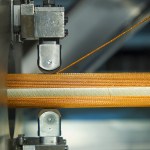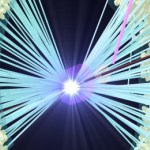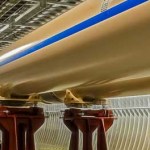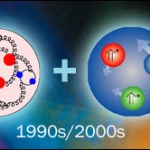RHIC
By Angela Leroux-Lindsey
Hold out your hand: Look closely. If you're outside on a sunny day, you might see dust motes and pollen dance in the air, perhaps landing on your skin, and bright rays of sunlight peek between your fingers. To the naked eye, your skin provides a barrier between your body and these exterior elements. The light refracts around your palm, not through it.
But microscopically, the air is filled with particles that have the ability to traverse solid matter. Sunlight is actually composed of tiny “packets,” or quanta, of light called photons. Most structures built of wood or…
Magnets are neverendingly awesome, and superconductors may be the ultimate in cool—they are, after all, literally extremely cold. And not just anyone has the tools to weave superconducting magnets with compressed metallic thread. It's a more essential skill than you might think.
Ultra-cold superconducting magnets steer high-speed particles inside colliders, keeping the beams tight and guiding them smoothly through the curves of circular racetracks. But those magnets generally rely on iron, an intrinsically magnetic metal, for key structures. That works beautifully for the particle …
Particle collisions aren't the easiest thing in the world to explain, but one of our physicists took this challenge to the extreme. In another Ten Hundred Words of Science submission, Brookhaven Lab physicist Paul Sorenson explains his work studying quark-gluon plasma with the Relativistic Heavy Ion Collider.
Where I work, we slam together small things to break them into even smaller things until we have the smallest things possible. This is how we know what matter is made of. We gave names to the smallest things in matter like “up”, “down”, “strange”, “top”, and “bottom”. Each of those…
Theoretical physicist Raju Venugopalan
We sat down with Brookhaven theoretical physicist Raju Venugopalan for a conversation about “color glass condensate” and the structure of visible matter in the universe.
Q. We've heard a lot recently about a "new form of matter" possibly seen at the Large Hadron Collider (LHC) in Europe — a state of saturated gluons called “color glass condensate.” Brookhaven Lab, and you in particular, have a long history with this idea. Can you tell me a bit about that history?
A. The idea for the color glass condensate arose to help us understand heavy ion collisions…
The positive and sometimes unexpected impact of particle physics is well documented, from physicists inventing the World Wide Web to engineering the technology underlying life-saving magnetic resonance imaging (MRI) devices. But sometimes the raw power of huge experiments and scientific ambition draw the recognition of those seeking only the most extreme and impractical achievements on Earth.
Brookhaven National Laboratory’s Relativistic Heavy Ion Collider (RHIC) smashes particles together to recreate the incredible conditions that only existed at the dawn of time. The 2.4-mile underground…
RHIC, the Relativistic Heavy Ion Collider at Brookhaven Lab, found it first: a “perfect” liquid of strongly interacting quarks and gluons – a quark-gluon plasma (QGP) – produced by slamming heavy ions together at close to the speed of light. The fact that the QGP produced in these particle smashups was a liquid and not the expected gas, and that it flowed like a nearly frictionless fluid, took the physics world by surprise. These findings, now confirmed by heavy-ion experiments at the Large Hadron Collider (LHC) in Europe, have raised compelling new questions about the nature of matter and…
This guest post is written by Brookhaven physicist Thomas Roser, Chair of the Collider-Accelerator Department. Roser, who earned his Ph.D. from the Swiss Federal Institute of Technology, worked at the University of Michigan before joining Brookhaven in 1991.
Thomas Roser
The chain of accelerators that leads into two of Brookhaven's major research facilities - the Relativistic Heavy Ion Collider (RHIC) and the NASA Space Radiation Laboratory (NSRL) - will soon have a new starting point.
A new ion generator, called the Electron Beam Ion Source (EBIS), will produce and accelerate beams with…
This guest post is written by BNL theoretical physicist Raju Venugopalan. After earning his Ph.D. from Stony Brook University in 1992, Venugopalan worked at several universities in the United States and at the Niels Bohr Institute in Copenhagen, Denmark, before joining Brookhaven in 1998. He is the leader of the nuclear theory group in Brookhaven's physics department.
Raju Venogopalan
Last week, members of the Compact Muon Solenoid (CMS) collaboration at CERN's Large Hadron Collider (LHC) announced that they've found a phenomenon that's similar to one observed by physicists at Brookhaven's…
This is the first in an occassional series about Brookhaven's Relativistic Heavy Ion Collider, or, as it's affectionately called, RHIC.
Lil John has a theme song for RHIC's latest experimental run.
Sorry, sorry! I couldn't resist. RHIC's actual ditty of the moment goes more like this. (Clean version, of course, RHIC doesn't want any soap in its linac).
RHIC, which has a maximum potential energy of 200 billion electron volts (GeV), collided gold ions at energies as low as 7.7 GeV this spring -- the lowest ever achieved in the machine. But why go so low?
Even at low energies, the gold-gold…
If you're American, chances are you'll be looking up this weekend for a spectacle of physics. But you also can look down from above -- way, way above -- to see the homes of some of the greatest physics experiments on Earth.
Brookhaven's Relativistic Heavy Ion Collider (RHIC) is probably one of the most visible particle accelerators from space.
Check out this satellite shot from 1982, when construction was underway for RHIC's predecessor, ISABELLE:
And this more recent aerial shot, taken in May:
RHIC is the first machine in the world capable of colliding heavy ions, which are atoms that…
It was a time of fierce (but friendly) international competition, when physicists still built things with their own two hands. Dotted with barracks and trenches, Brookhaven was yet to fully transform its face from army camp to research institution.
In the early 1950s, the physics community was at the horizon of the boom of discoveries that define our understanding of the universe.
Before quarks, neutrinos, and CP violation could be found, scientists needed a tool much more powerful than Brookhaven's Cosmotron -- the leading particle accelerator of the time. The problem: building an…






